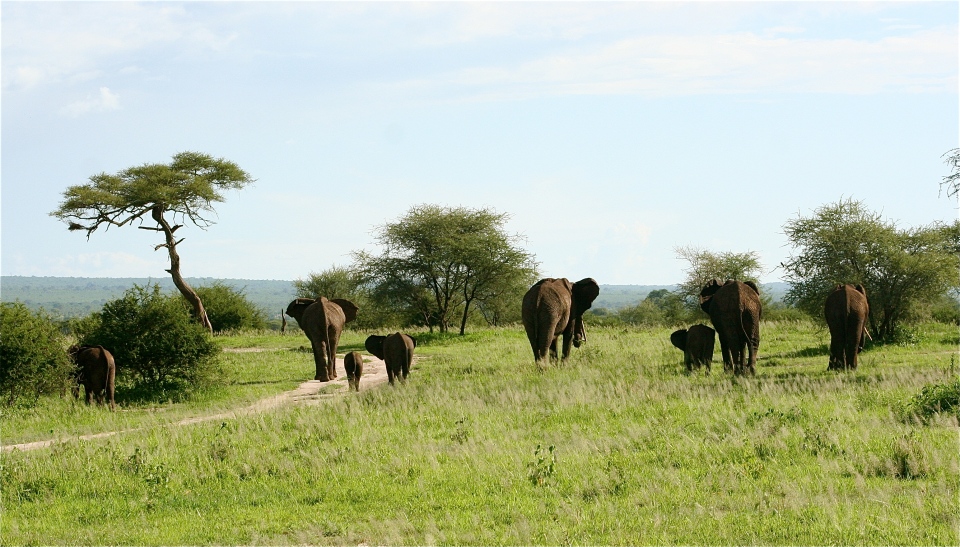
Loxodonta africana. Tarangire National Park has the largest tembo/elephants.
Kwa rafiki zangu wanaopenda wanyama. For all my animal loving friends. Here are the safari pics I promised. As far back as I can remember, Africa, her people, and her animals were always in competition with classical music in my soul. Lions especially. The battle still rages. For now, Africa has the upper hand. I really must resolve this – but that is fodder for a different blog.
I generally shoot around 550 pics a day on safari, then cull them down to between 80-100. This is a compilation of what I consider the best of each culled set. I’ve included the Kiswahili name for most animals. I still have to identify some of the birds, so for those I don’t know I’ll just call them ndege/bird. My 2 year old toddler command of the language isn’t up to that yet. I’ve also included most of the scientific names for those of you who are big science geeks like I am. This post is mainly pics with mini biology lessons peppered with biological terminology. Sorry, not sorry – can’t help myself. If you’re not interested in the science, just scroll through and enjoy the pics.
Be forewarned – I’ve included some graphic pics of animals killed by lions.
An estimated 20% of Africa’s large animals reside in Tanzania. My goal is to visit each and every park and conservation area at least once before I leave. Anyone care to place a wager?
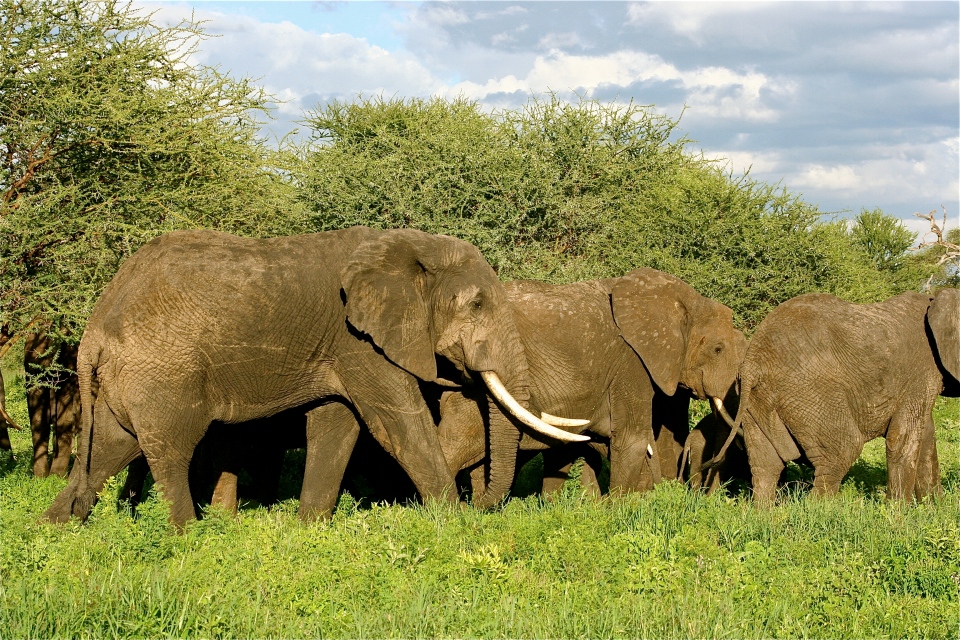
Loxodonta africana, Tarangire National Park. Due to poaching, tusks this long aren’t often seen.
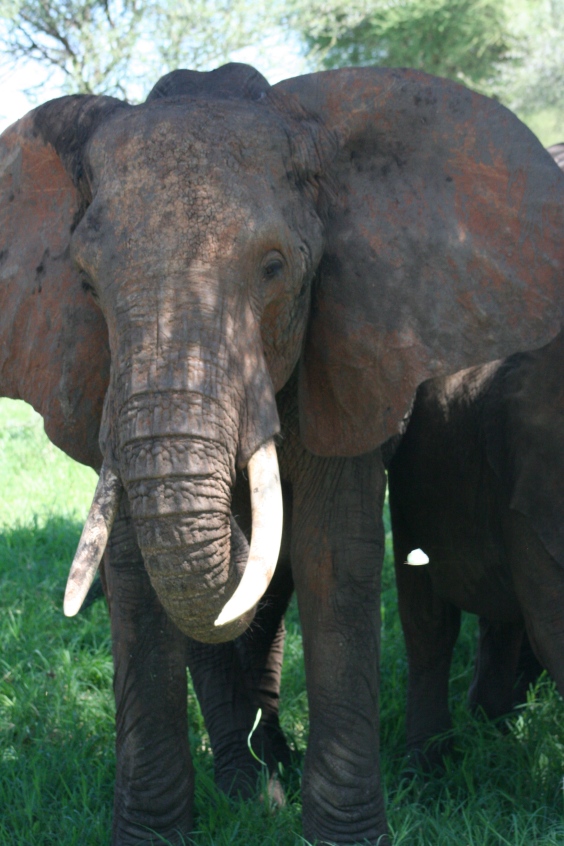
This is the matriarch of the herd. The red coloration is from the red dirt she threw all over herself. This is both protection from sun and parasites. Yes, elephants can get sunburned. There is a lot of iron in Tanzanian soil.
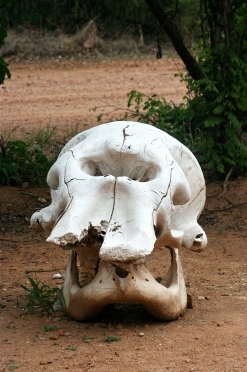
Ever wonder what an elephant skull looks like?
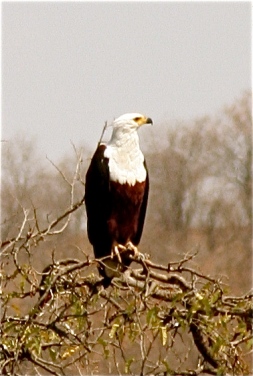
Ndege/Bird. Haliaeetus vocifer, Ruaha National Park. African fish eagle.
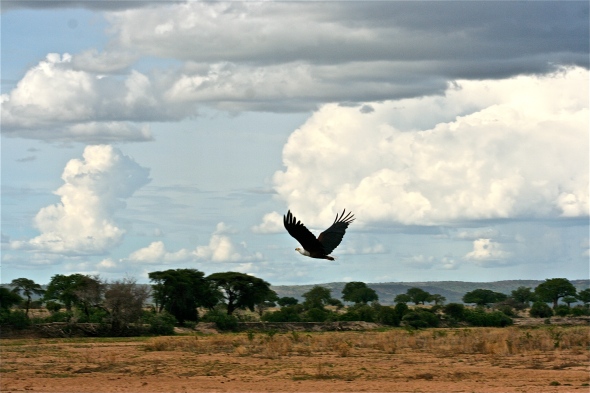
Ndege/Bird. Haliaeetus vocifer, Ruaha National Park. African fish eagle in flight.
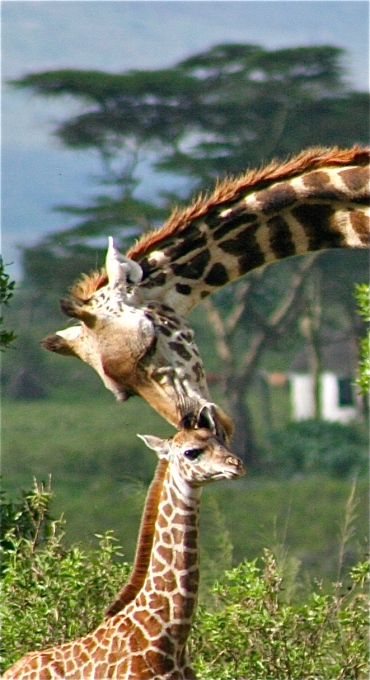
Twiga. Giraffa camelopardalis reticulate, Arusha National Park. Reticulated giraffe mama lovin’ on her new baby. The calf was less than a month old. You can tell because it’s height still placed him under his mama’s belly. One of our volunteers, Bette, converted this into a painting for me. Thanks Bette!
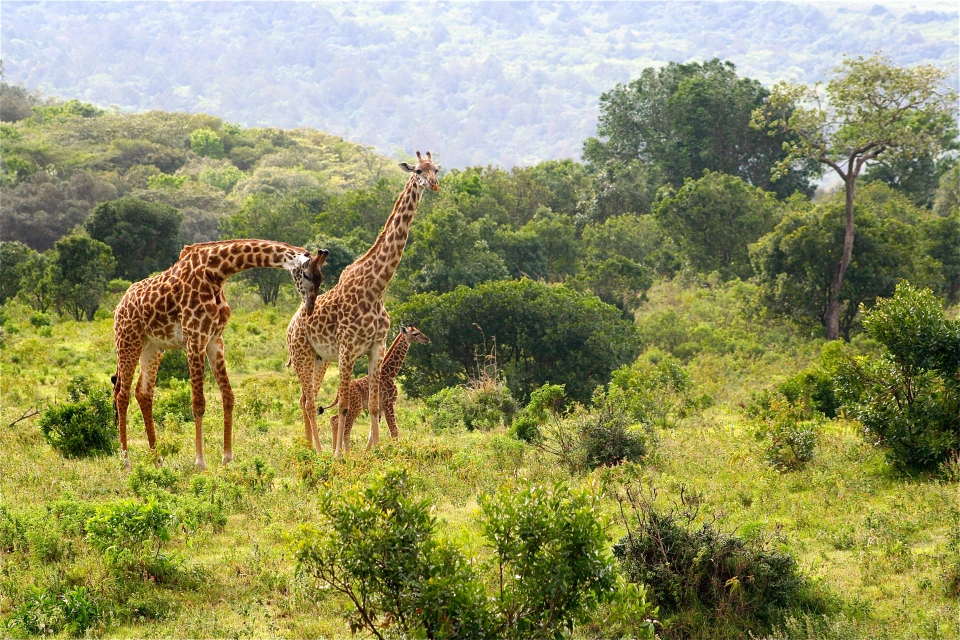
Twiga. Giraffa camelopardalis reticulata, Arusha National Park. Retiulated giraffe family. You can see how small the calf is. Arusha was so green and lush!

Twiga. Giraffa camelopardalis tippelskirchi, Ruaha National Park. This is one of my favorite pics. This is a male Maasai Giraffe. It is also known as the Masai giraffe and the Kilimanjaro giraffe. It is the largest of the 3 giraffe subspecies and the tallest land mammal. Hmmm….can you have a tall aquatic mammal? If you look closely, you can see the difference in coloration between the Maasai and Reticulated giraffes above.
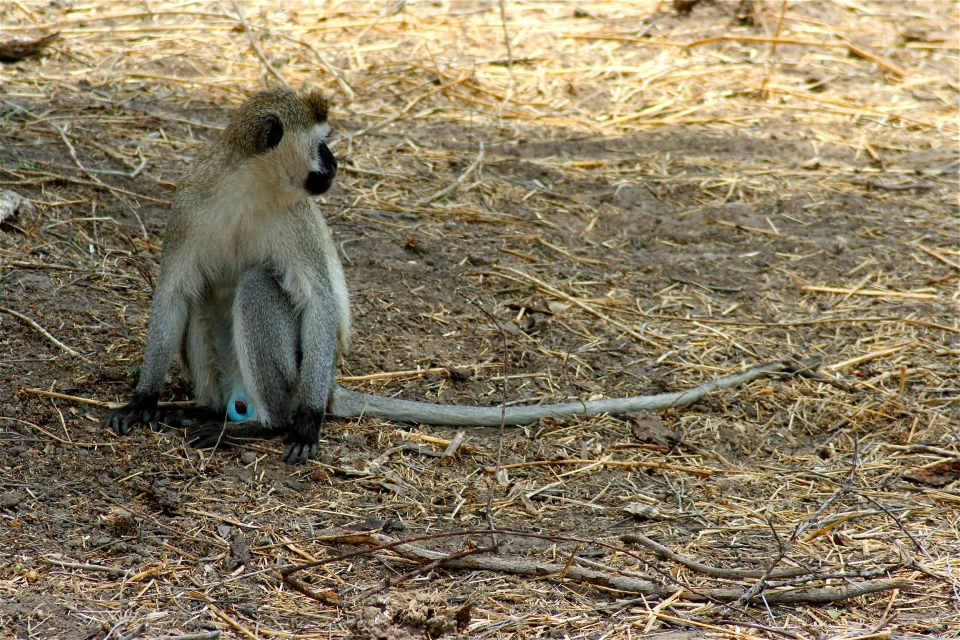
Tumbili / Monkey. Male (obviously) Vervet Monkey, Clorocebus pygerythrus, Ruaha National Park. Also affectionately known as Blue Balls.
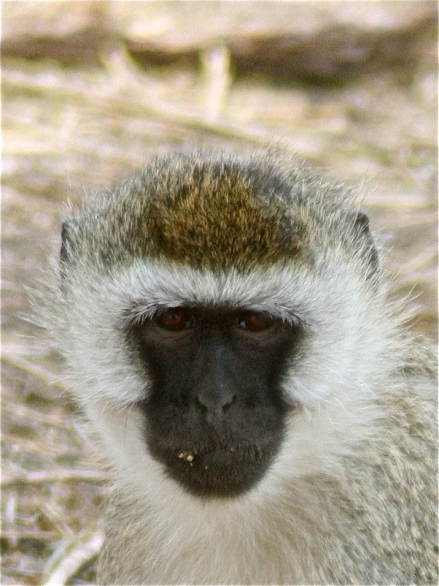
“Hey! My face is up here!”
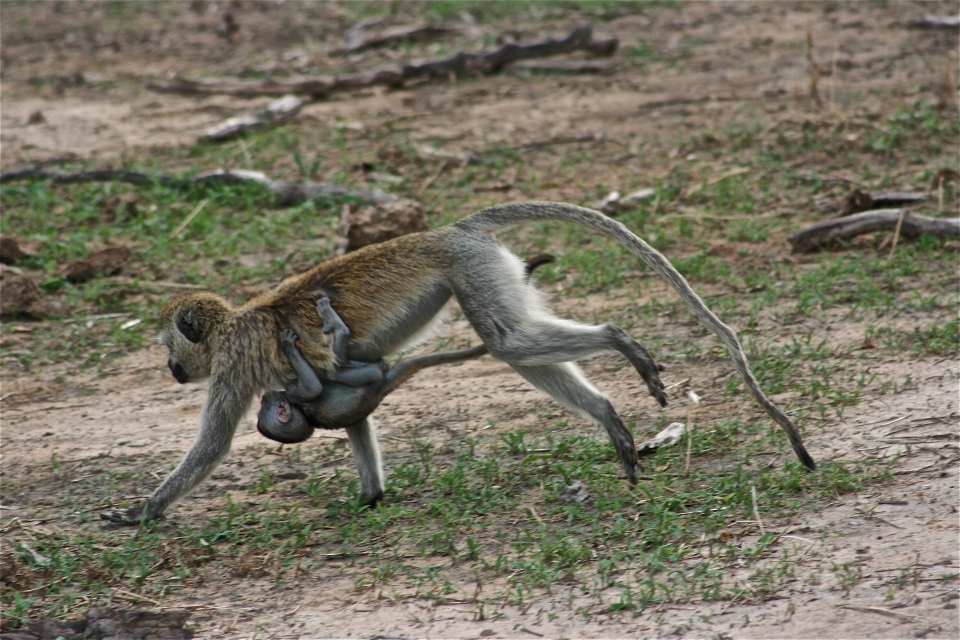
Clorocebus pygerythrus. Arusha National Park. Female Vervet Monkey and infant. In both the Vervet and Blue Monkeys (below) troops, the pregnant and postpartum females seemed to gather together in maternity groups. I don’t know if this is always true or true of all monkeys, but it was interesting.
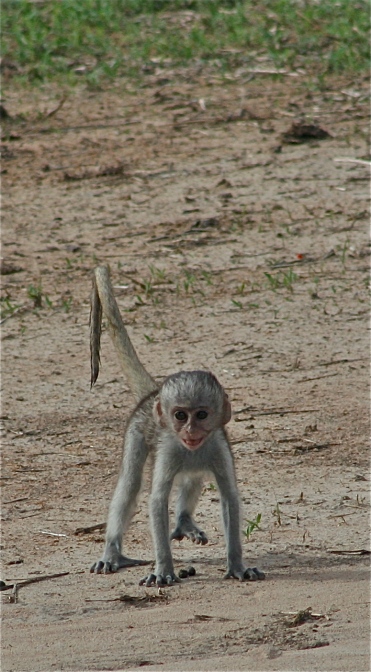
The Vervet Monkey infants are kind of creepy looking. Alien-like faces and giant tarantulas for hands and feet.
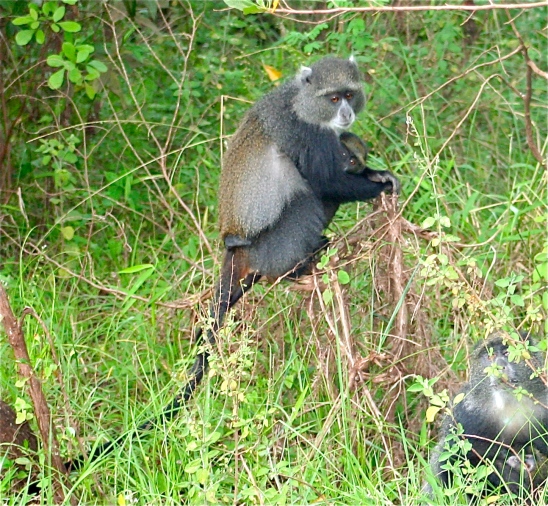
Tumbili / Monkey. Cercopithecus mitis, Arusha National Park. All African monkeys are old world monkeys. This is a Blue Monkey mama and baby. Not the best framing, but it’ll do till I get back there. Blue Monleys aren’t really blue, but in the right light (which I didn’t get) there is a fine ring of hair around the face that can sometimes look blueish.
Okay, the biology teacher in me needs to give a mini anthropoid evolution lesson. All anthropoids began in Africa. Somewhere around 30mya some decided to get outta Dodge and migrate to South America. There they evolved in isolation and became the new world monkeys. Meanwhile, back at the ranch, the African anthropoids split into 2 major groups. The hominoids became the old world monkeys and the hominids became the apes; which includes humans. We did not descend from apes or monkeys. This is a common misconception that drives me absolutely nuts. We share a common anthropoid ancestor with them. We are 98% genetically identical to our cousins, the common chimpanzee (Pan troglodytes), because we share this ancestor. If you don’t believe me just go watch an elementary school yard at recess.
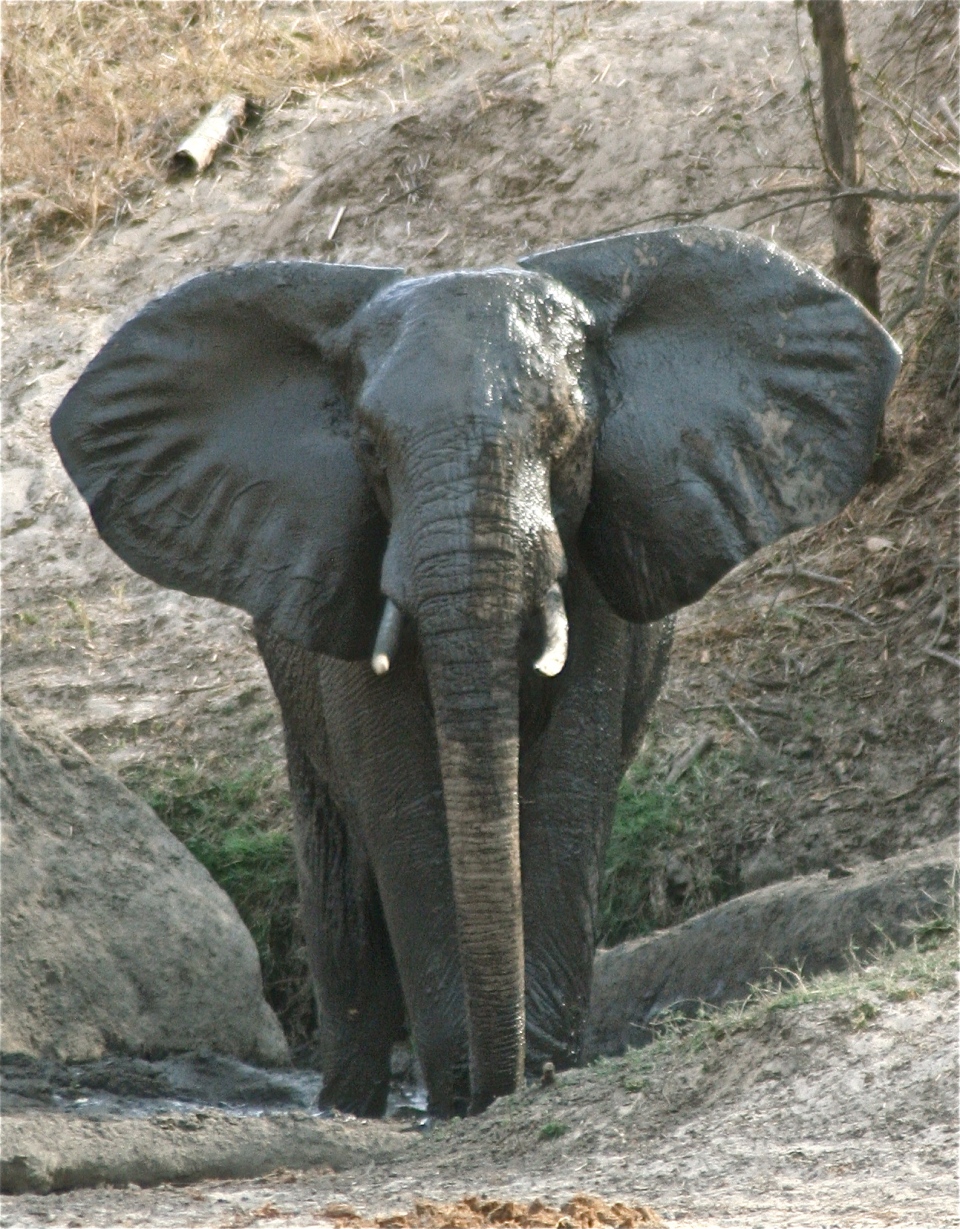
Tembo / Elephant. Loxodonta africana, Ruaha National Park. This big bull just finished a nice refreshing bath. Wish I could’ve joined him. This day was blazing hot.
Fun factoids: Elephants emit infrasonic sounds. These are sounds with frequencies lower than 20 Hz; lower than humans can hear (20 Hz is our lower limit). Low frequencies travel farther than high frequencies and are thus ideal for long distance communication. This is very important for elephants because they live in very tight knit family groups. These infrasonic sounds are considered a defining characteristic of all three African elephant species. Yes, there are 3 species of African elephants. The savannah elephant (Loxodonta africana) which resides here in East Africa, and the forest elephant in central Africa (Loxodonta cycloits), have genetically distinct mitochondrial DNA. The west African elephant has been diverging from the other 2 for a couple million years. Not long. The genetic studies are very recent and I could not find the binomial name for the West African subspecies. FYI, there are also 3 subspecies of Asian elephant, Elephas maximus, and they also emit infrasonic sounds.
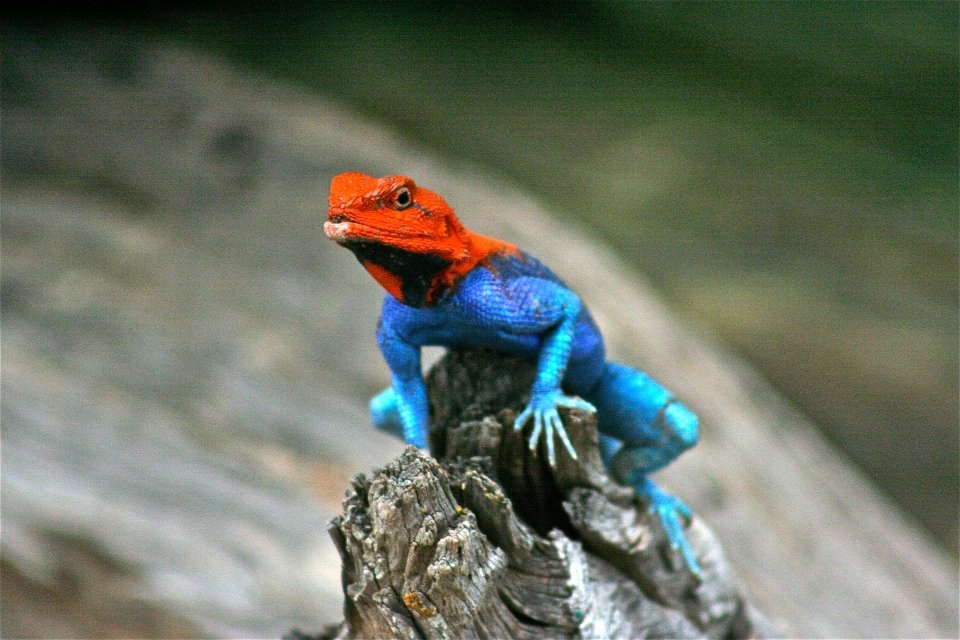
Mjusi / Lizard. Agama agama, Ruaha National Park. This is a dominant male. Lesser males and females have muted colors. also known as the Rainbow Lizard.
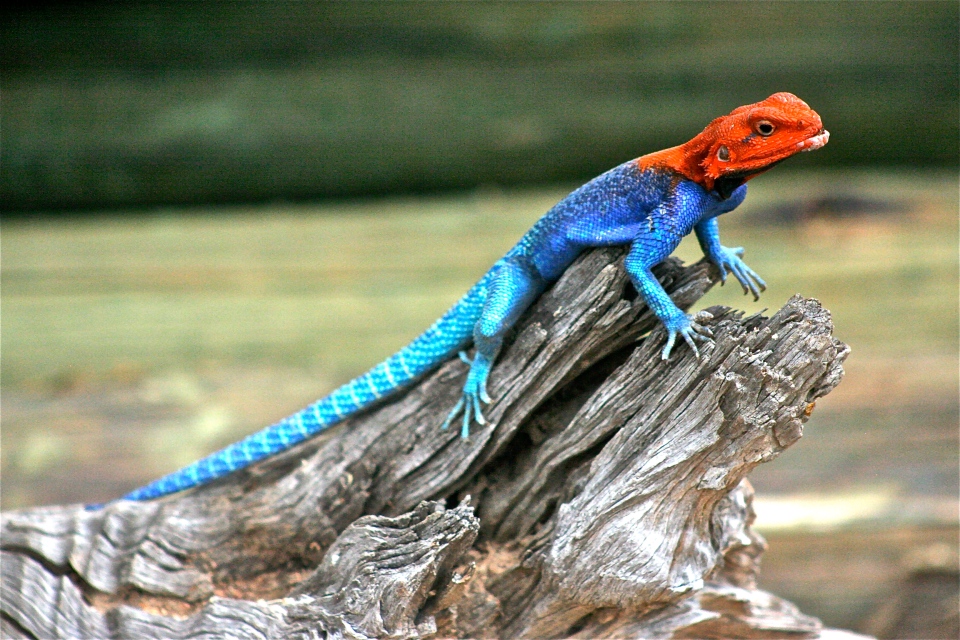
Mjusi / Lizard. Agama agama, Ruaha National Park. We have these in Berega, too. The males will bob their heads attempting to look suave and attract the ladies.
My second safari to Ruaha yielded not one, but two sitings of lions guarding a kill. I have yet to see an actual hunt, but I can now say (okay…brag) that I’ve seen 3 lion feasts in my life. Lord willin’ and the creek don’t rise, I’ll someday get shots of the hunt.
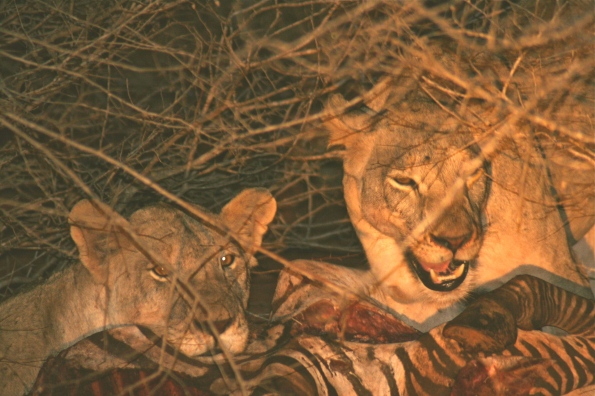
Simba / Lion. Panthera leo. This was taken on private land bordering Tsavo National Park, Kenya. The land owners granted the research team access to their land for the duration of the study. The reddish cast on the pic is from the red light used for night shots. It’s easier on the animals than bright white. We weren’t really interested in pissing off a lion.
The above pic was shot in ’05 when I joined an Earthwatch expedition as a data collector (aka, lackey). The study was to determine why the maneless lions of Tsavo have juvenile manes or no manes at all. They were also studying why lions in this region go man eating more often than in other areas. I highly recommend the film “The Ghost and the Darkness,” with Michael Douglas and Val Kilmer. The story is true, I’ve read the book seen the bridge. These lions are the decedents of the lions in the movie. Hollywood, of course, used full-maned lions. These lions are juveniles. There is no way to tell if they are male or female from this pic.
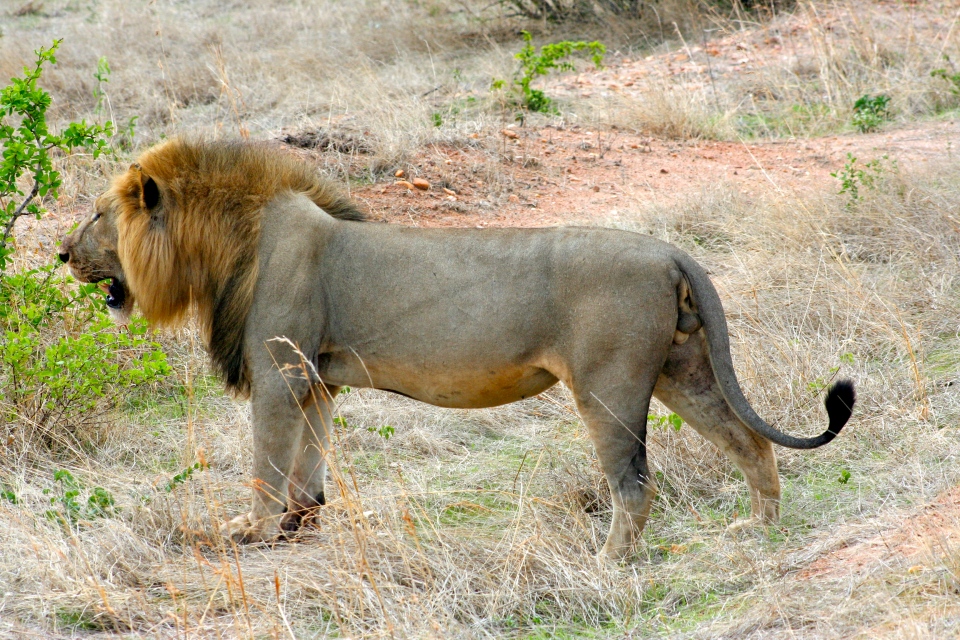
Simba / Lion. Panthera leo, Ruaha National Park.
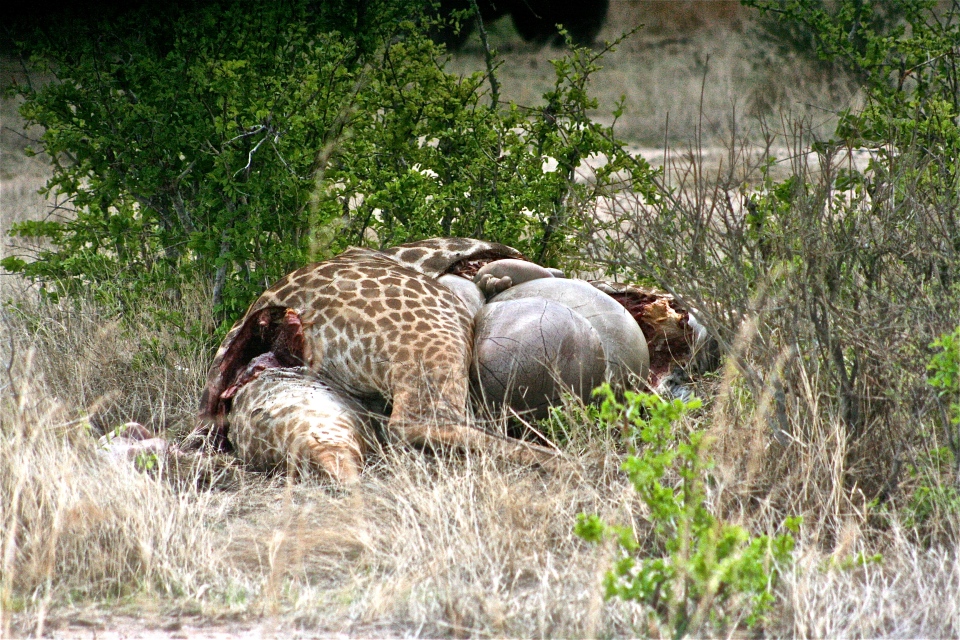
This is what the big boy above was guarding. We saw him chase off a jackal. I’m thinking he must be in his prime to have brought down an adult giraffe solo. That bloated stomach? Can’t tell you how glad I am it didn’t burst while we were there.
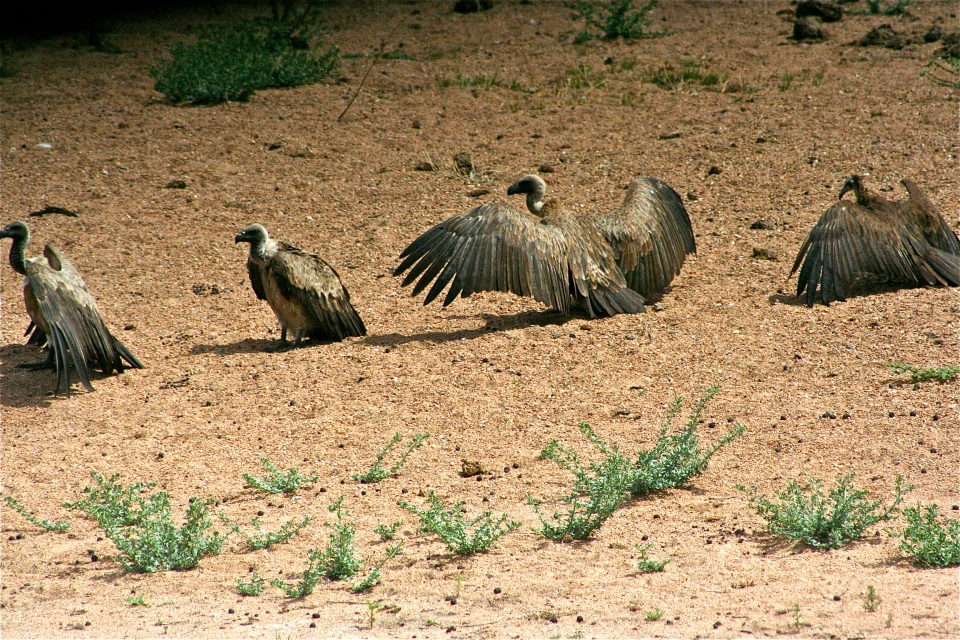
Tai / Vultures. I think these are Ruppell’s Griffin Vultures, Gyps rueppellii. Ruaha National Park.
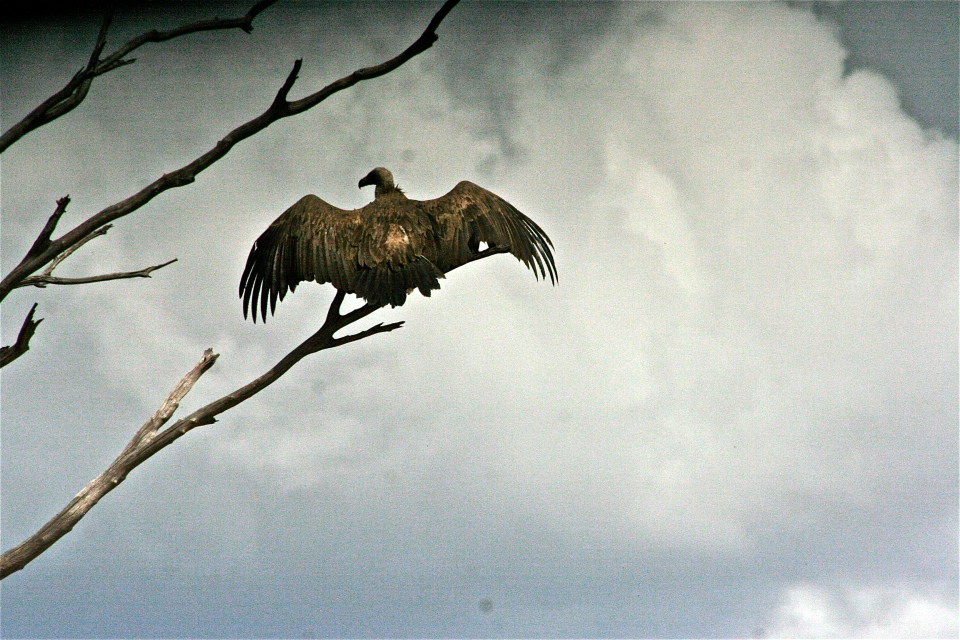
Tai / Vulture. Gyps rueppellii (?), Ruaha National Park
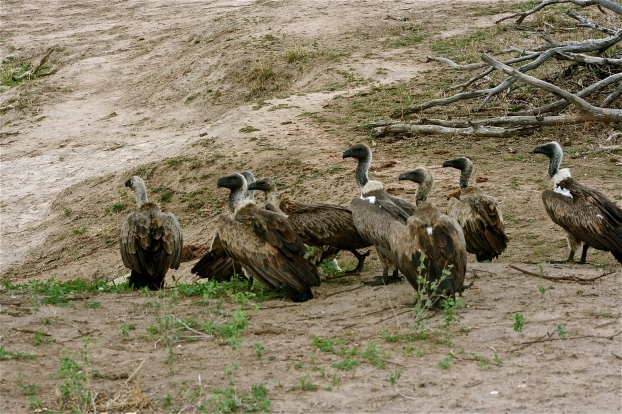
Alright, when from a distance you see trees loaded with vultures, vultures in the air and vultures on the ground, you know you’re about to see something pretty cool.
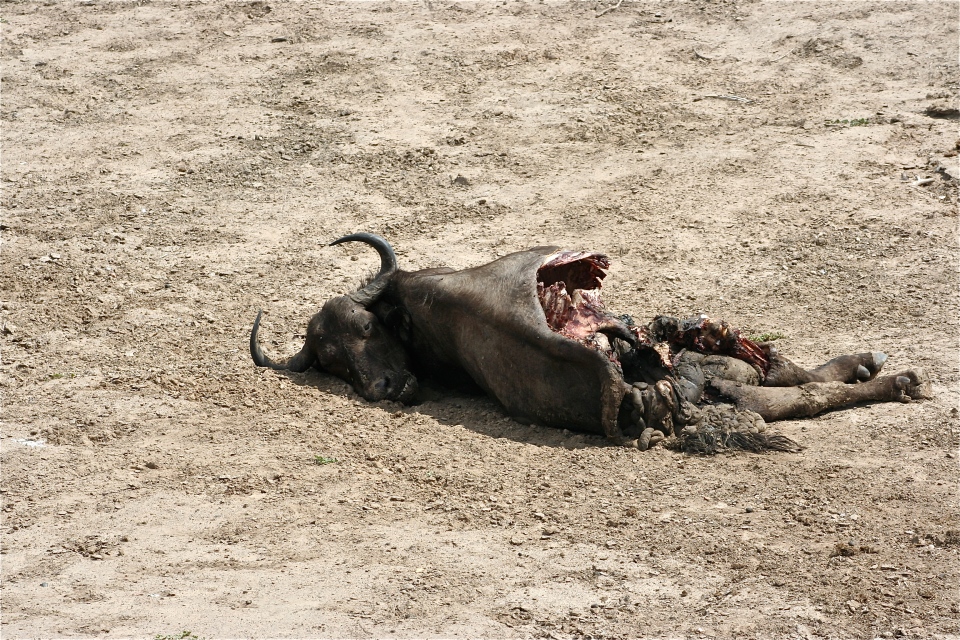
…and we did. Problem was, there were vultures everywhere except on the carcass. Hmmm…. Cape buffalo, Synerus caffer (or at least it was).
We were on a small outcrop of land above the kill. I’m shooting pics and zooming in; still wondering why the vultures were being so tentative. Finally, a few started cautiously moving in one at a time. Eventually the rest ran, flew, swooped, and hopped over. They began just ripping this buffalo apart like there was no tomorrow. A flock of vultures can strip a carcass of this size clean in 20 minutes.
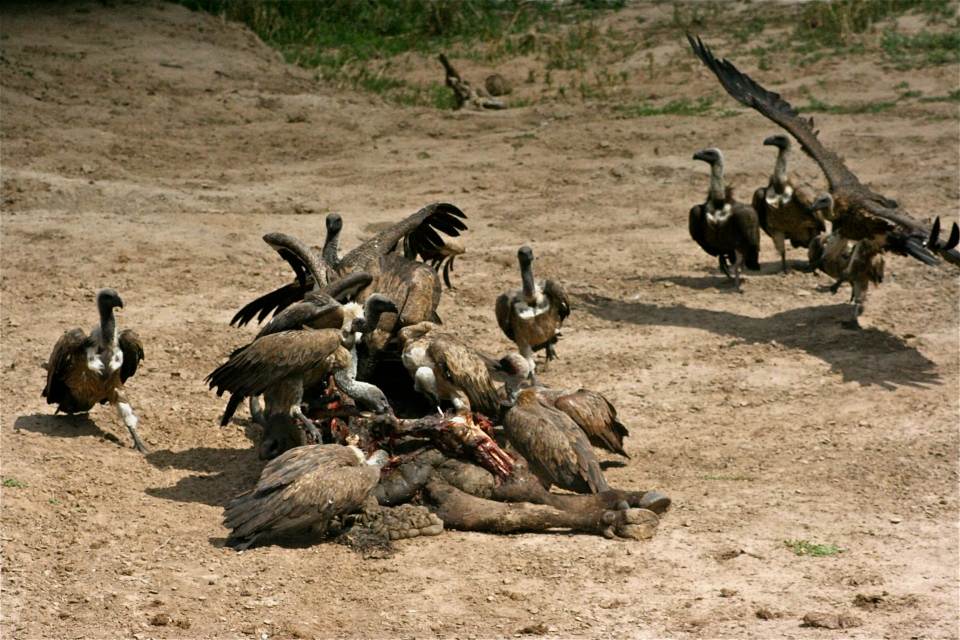
At one point this buffalo was obliterated in a whirling, tangled mass of feathers and beaks.
Suddenly, my view became a confusing conglomerate of wings, beaks, and feet. The vultures just exploded in every immaginable direction. It happened so fast I didn’t realize what I was seeing – until the feathers cleared and I was staring into the face of a charging lioness. I completely forgot I was looking through a zoom lens and just absolutely froze and missed the damn shot of a lifetime. We were in an open top Land Rover and she didn’t seem to be stopping anytime soon. We were not far from her – maybe 15-20 feet. By the time I collected myself she had stopped on a dime and turned. The pic below is all I got of that charge. She could care less about us. She was after the vultures.
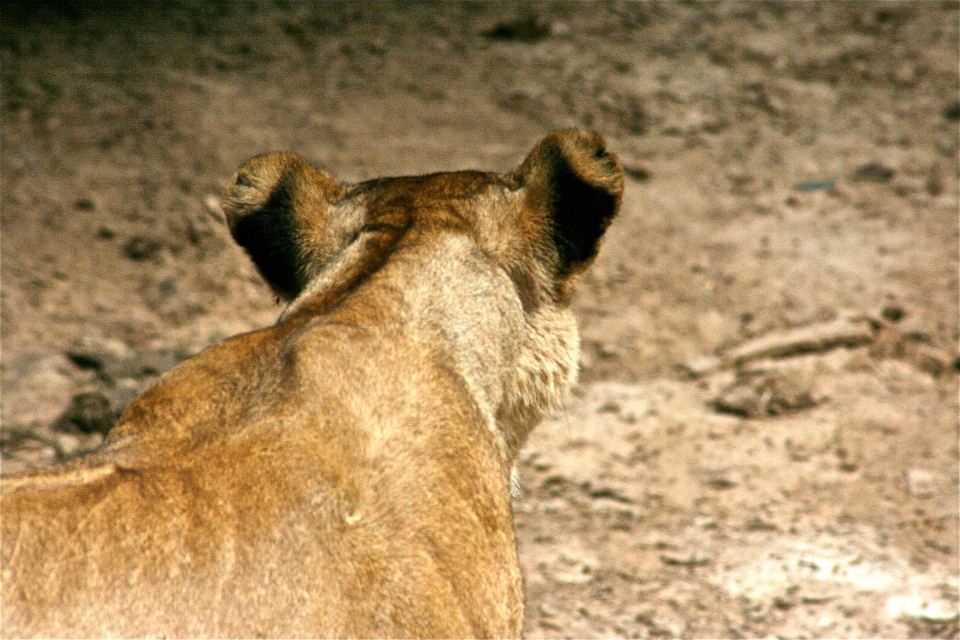
Simba / lion. Panthera leo, Ruaha National Park.
When she went and hid behind the little cliff, we knew the vultures would return. There was going to be an encore.
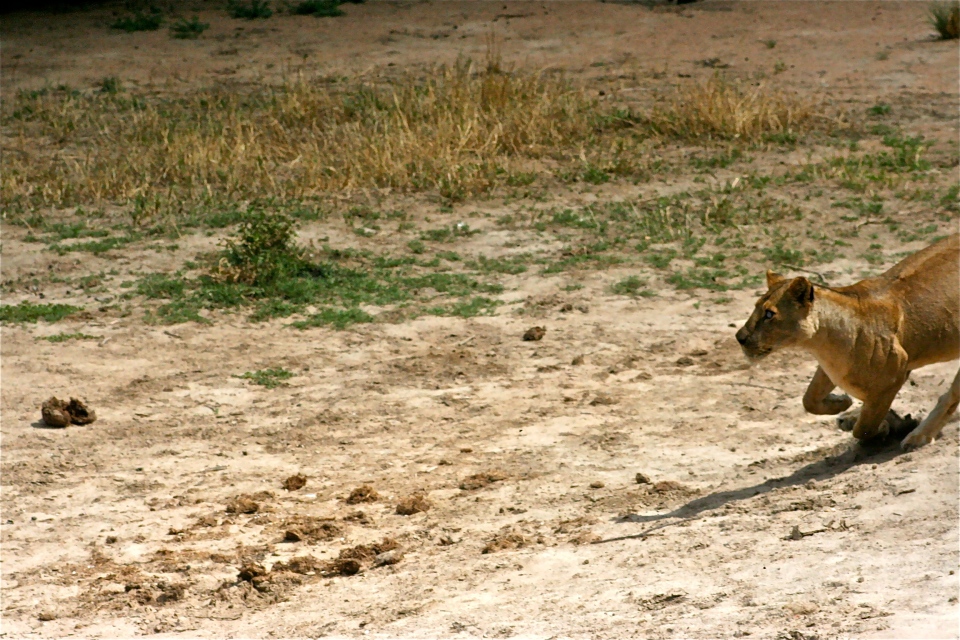
Simba / Lion. Panthera leo, Ruaha National Park. The charge begins. She went from zero to top speed in fraction of a second. It was vehement.
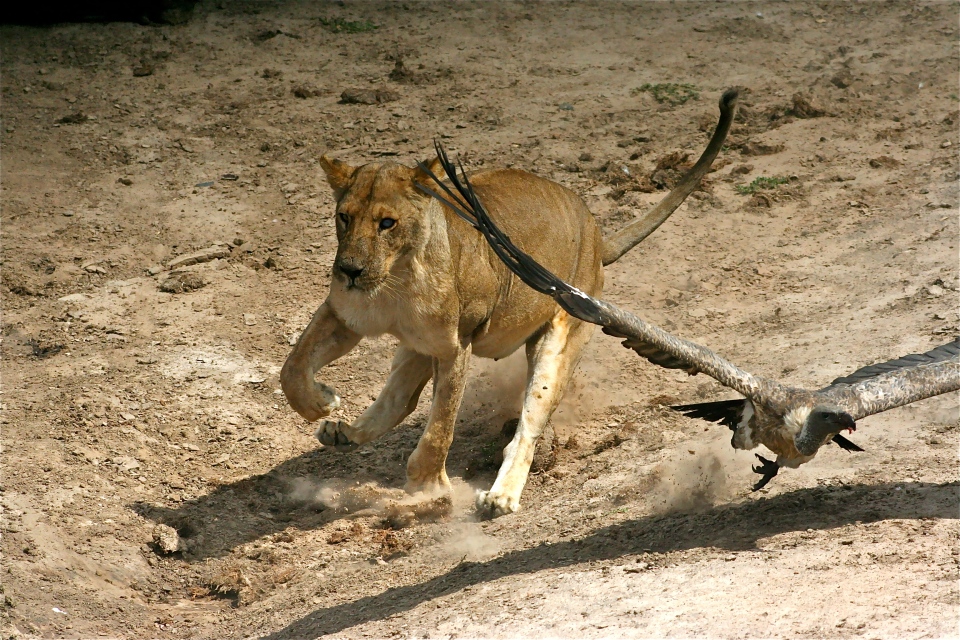
Simba / Lion. Panthera leo, Ruaha National Park. This is absolutely my all time favorite shot. I had no idea I had gotten that vulture in the pic. Lions can take out several vultures in one swipe. If you look closely, the lioness is missing the tuft at the end of her tail and her left eye is blind. Must’ve been one hell of a fight. That’s probably why that vulture still lives; she couldn’t see it.
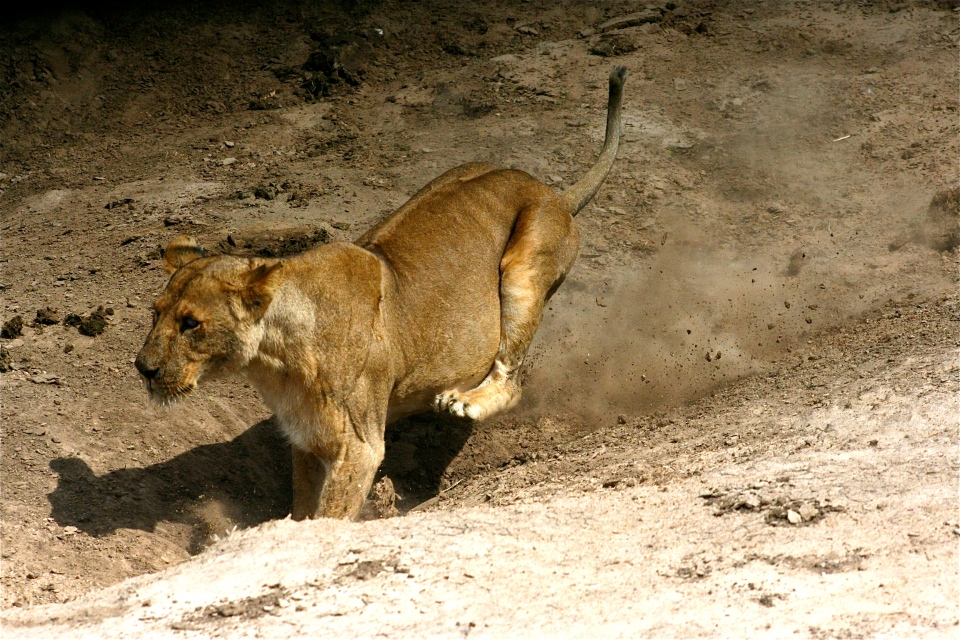
Simba / Lion. Panthera leo, Ruaha National Park. The quantity and velocity of dirt displaced by this cat could almost have become shrapnel. Her belly may have been stuffed with meat, but this mama was movin’. Just pure muscle. An unadulterated powerhouse of motion.
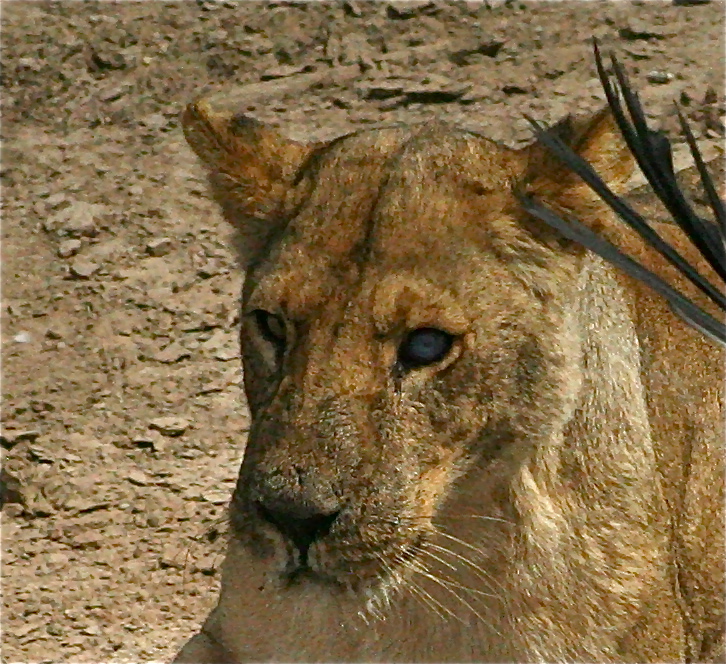
Simba / Lion. Panthera leo, Ruaha National Park. I cropped and enlarged her face so you could see her blind left eye. I’m partial to cats with blind eyes. My cat back home is also blind in one eye.
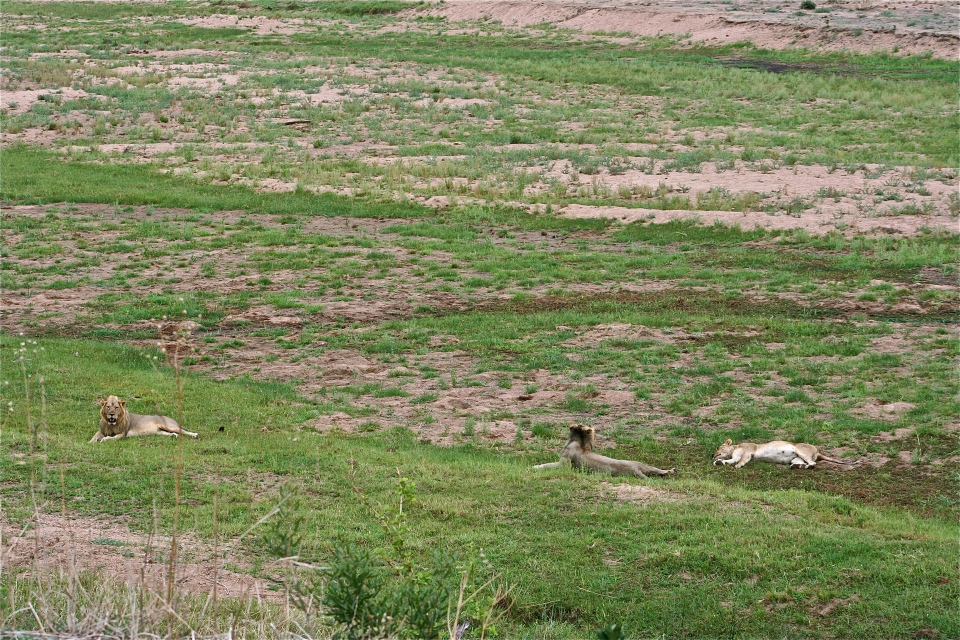
A boring shot, but it does show how lucky we were. This is normally what lions do 23 hours a day.
The female is on the right and there’s a 3rd male out of sight guarding the kill. A bit strange since a pride consists of females and their cubs. Males come in for mating and otherwise exist in small bachelor prides or go it alone. They weren’t mating because a mating pair will not hunt for the 3 or so days of….well, you know. I’m not sure what was going on here.
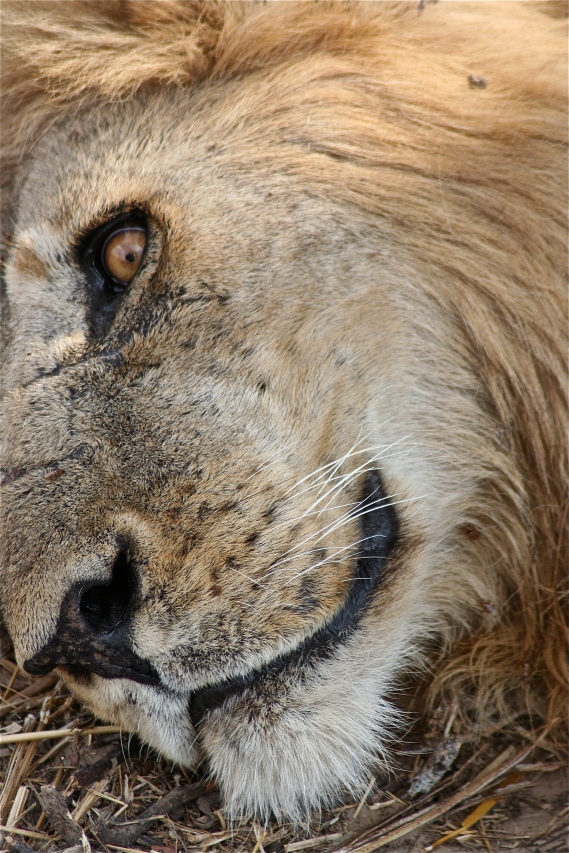
Simba / Lion. Panthera Leo. This young male was sleeping under a tree approximately seven feet from the truck. At one point he opened his eye and stared my camera down. I admit it was a tad unnerving. Lisa, my housemate, is going to do a digital painting of this is cool colors.
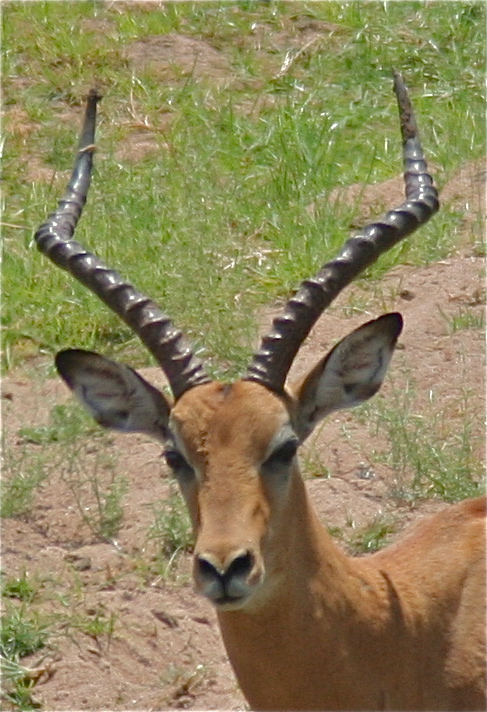
Swala Impala / Impala. Aepyceros melampus. The females lack horns. Seriously, these are so abundant we started calling them rats. Trying to get a pic face on like this was hard. They look directly at you until you put a camera up to your eye.
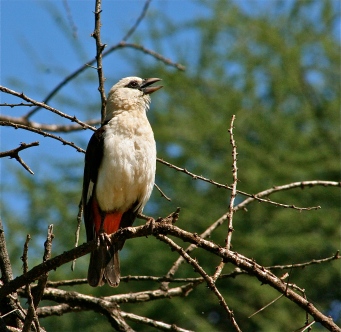
Ndege / Bird. Dinemellia dinemelli, White-Headed Buffalo Weaver. They live in large, communal nests.
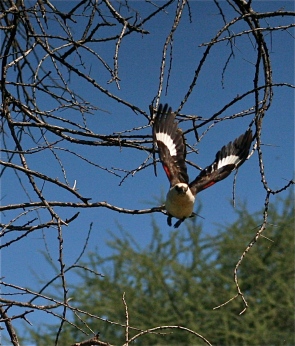
Ndege / Bird. Dinemellia dinemelli, White-Headed Buffalo Weaver in flight.
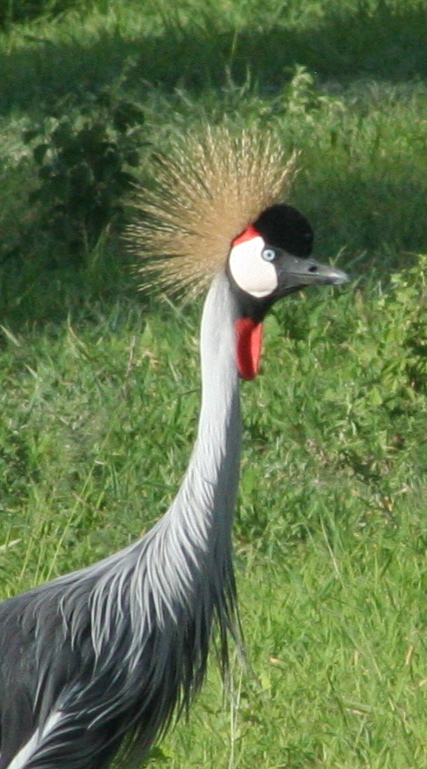
Ndege / Bird. Crested Crane, Tarangire National Park. Balearica regulorum. One of my favorite birds.
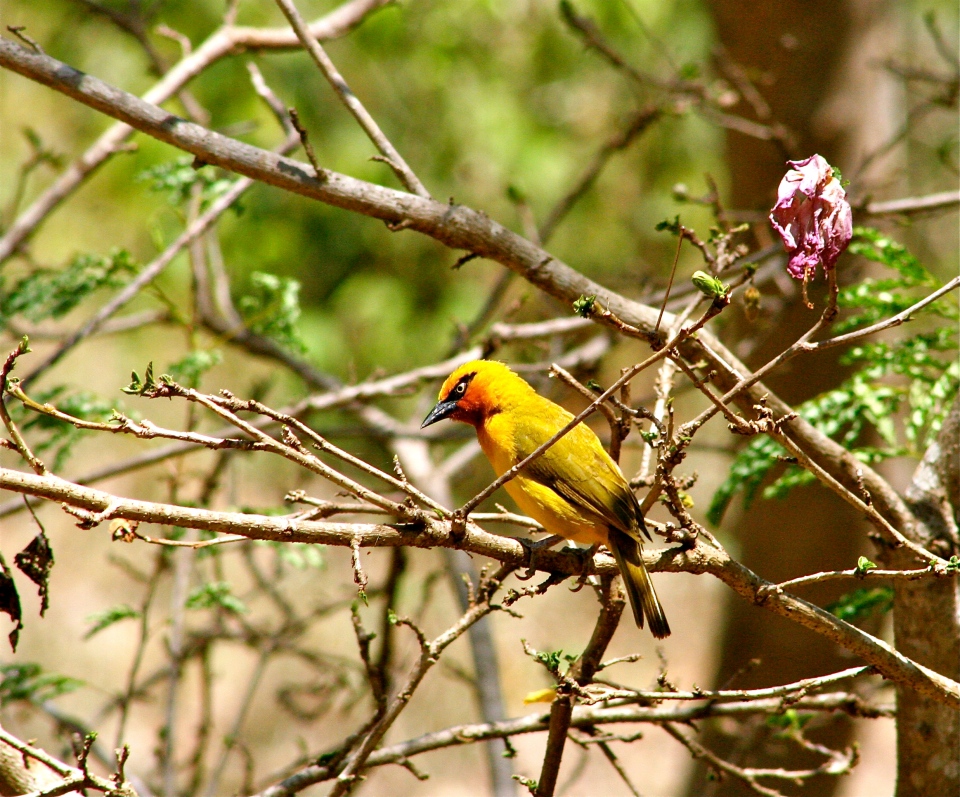
Ndege / Bird. This is a Spectacled Weaver, Ploceus oculars. This was taken in my backyard, which is literally Africa. I’ve gotten 25 different species so far and all I’ve had to do was sit on my butt and shoot. There’s a few I’ve seen but haven’t gotten the pic yet. BUT…the most exciting part is Lisa is going to take this pic and do a water color painting for me!!

Kiboko / Hippo Hippopotamus amphibious. This hippo was blowing bubbles in the river just for the fun of it. Be a hippo.
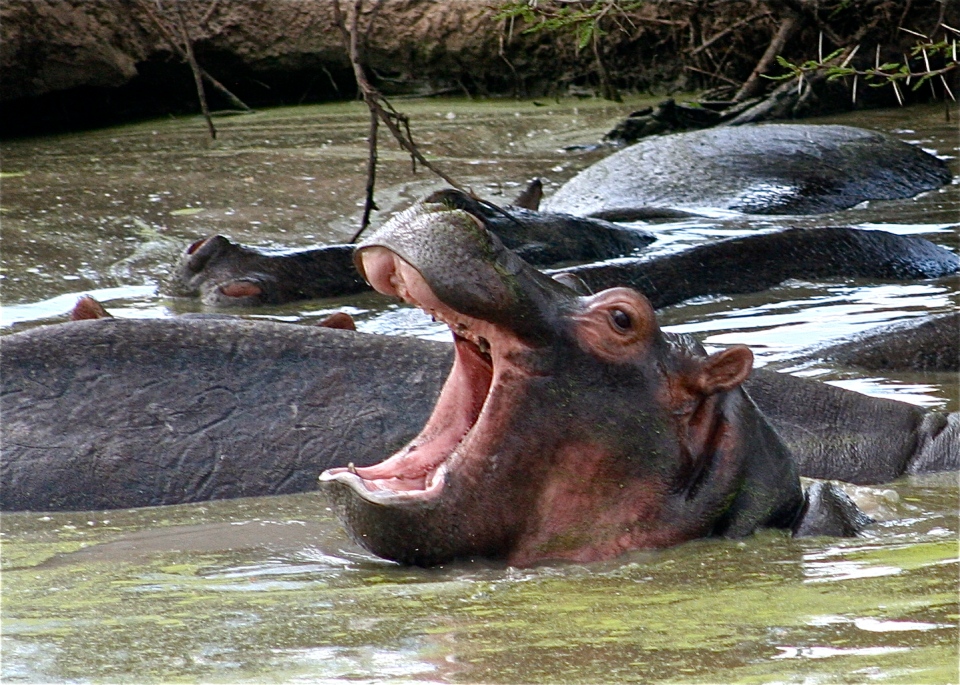
I call this one “Diva.”
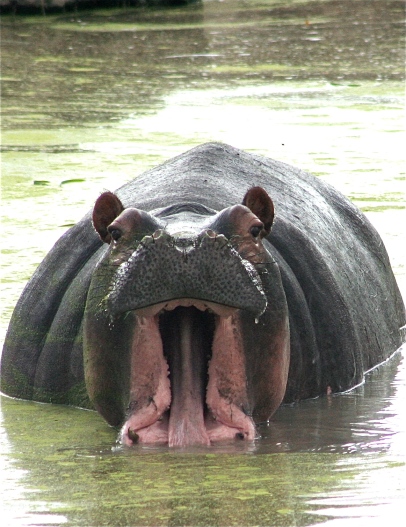
- AAAAAA. Relax your jaw, relax your tongue, relax your lips. EVERYTHING should be relaxed. Support, sopranos, support! (The pic is overexposed, but I still like it.)
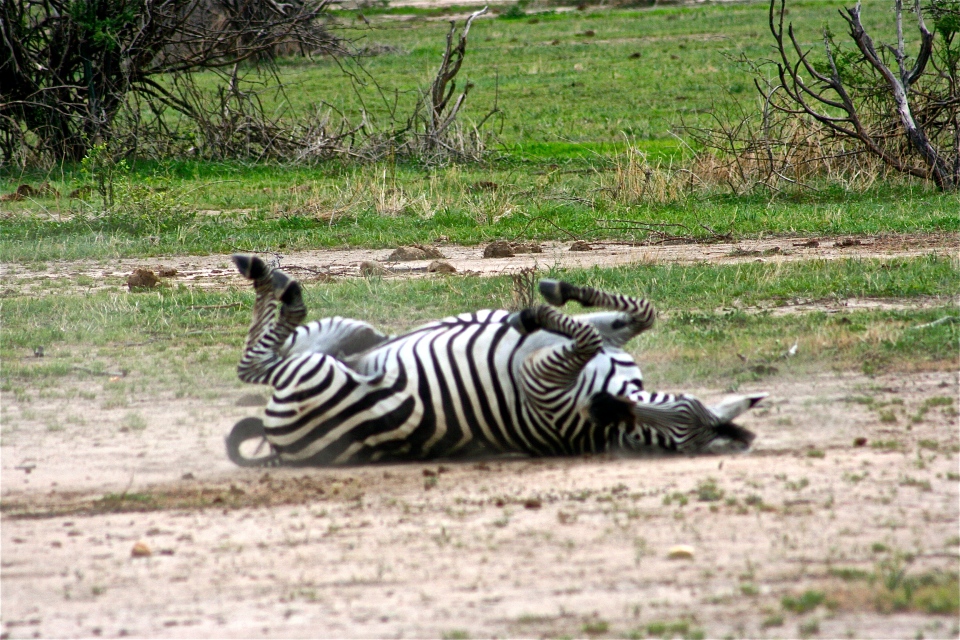
Equus quagga / Plains Zebra (formerly Equus burchellii). Ruaha National Park. This mare was having a grand ol’ time rolling in the dirt. Those of you familiar with horses know this only happens immediately after a bath.
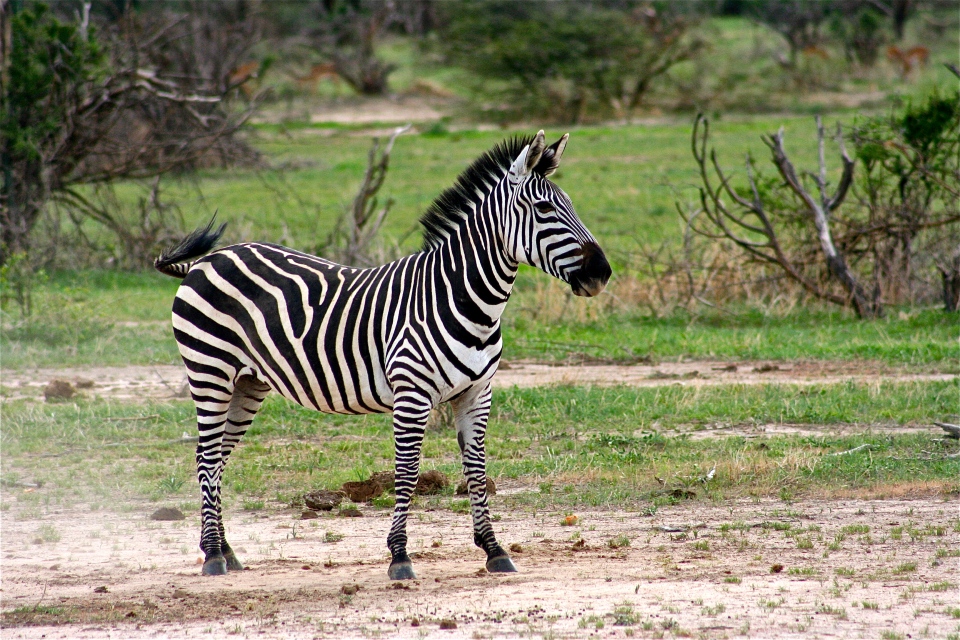
Equus quagga / Plains Zebra. Ruaha National Park. Feelin’ sassy after that nice roll. I love the black and white stripes against the green. The stripe pattern on a zebra is as unique as our finger prints.
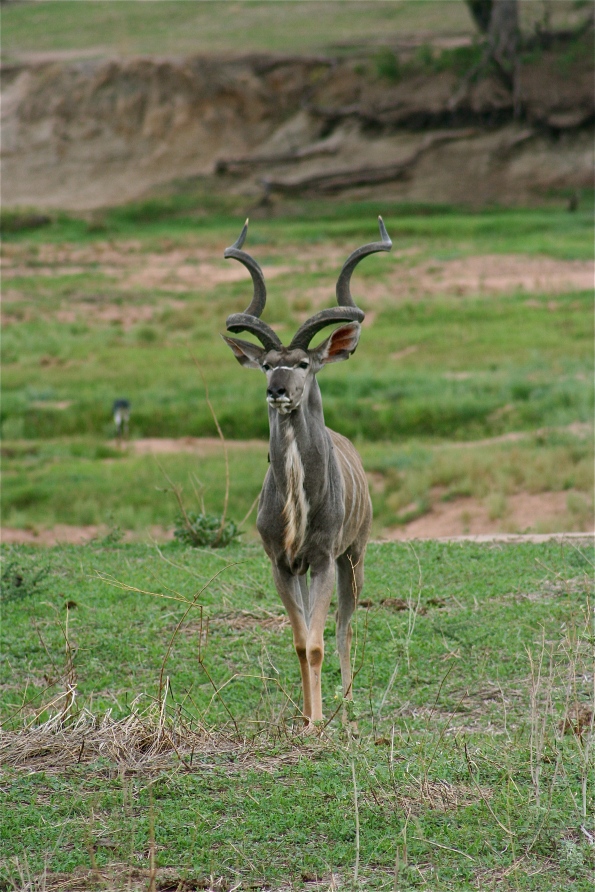
Tragelaphus strepsiceros / Greater Kudu, male. Ruaha National Park. The majesty with which he walked cannot be captured in a still shot. Just think “Bambi’s daddy” and you’ve got it.
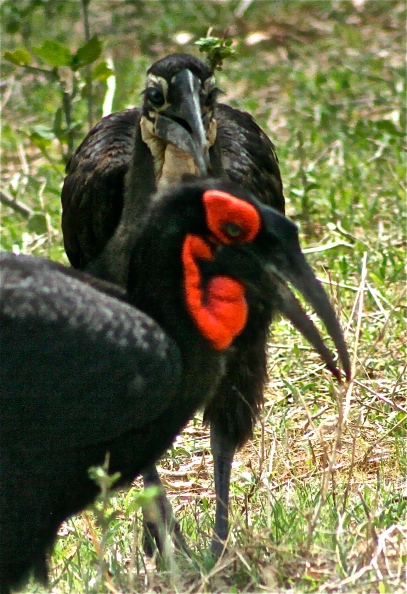
Bucorvus leadbeateri / Southern Ground Hornbill. Ruaha National Park. The one with the red head is the adult.
Having the honor of being the largest hornbill in Africa, this is Zazu’s cousin (Kudos if you got The Lion King reference). There is a lot of myth surrounding this bird. They are harbingers of rain be it welcome or not. If they are feeding in a field, that’s where you want to graze your cattle. They will bring you wealth, BUT, if one lands on or near your house and you don’t’ chase it away immediately – somebody is going to die. It’s bad luck to kill one, unless you need rain. One thing they do that isn’t myth is they’ll break the windows in your house because they think their reflection is another hornbill needing chasing off.
I haven’t heard their booming, call in the early morning because, well….morning.
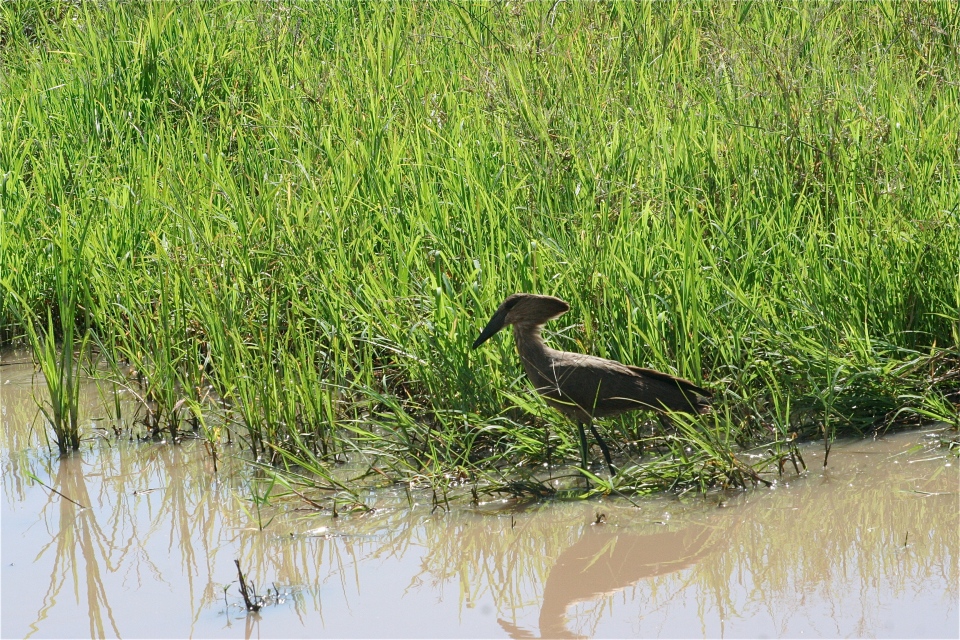
Scopus umbretta / Hamerkop. Tarangire National Park. Not much to look at except for that head.
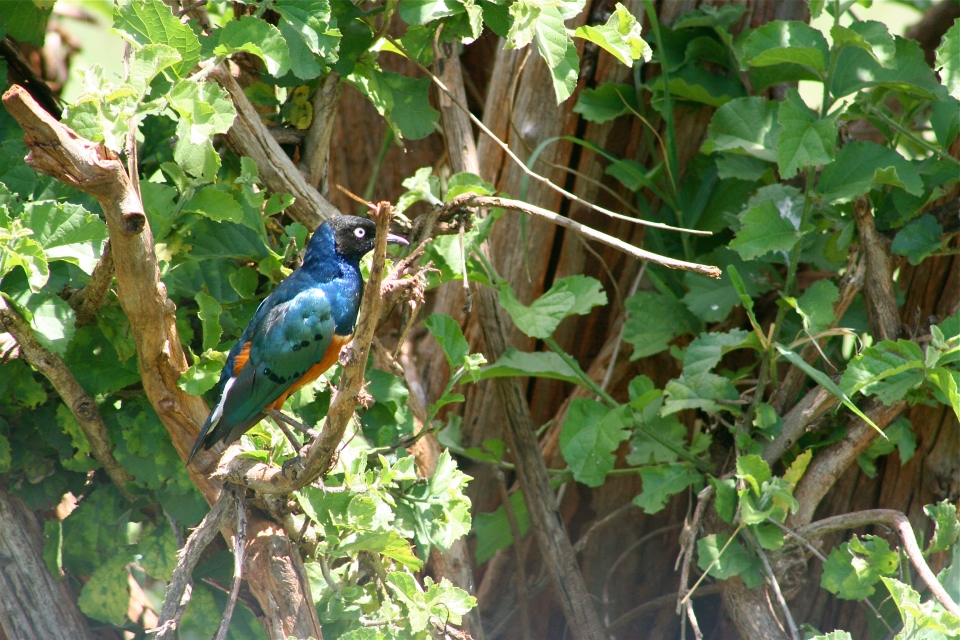
Lamprotornis superbus / Superb Starling. Tarangire National Park. They have an oil gland that makes their feathers so shiny.
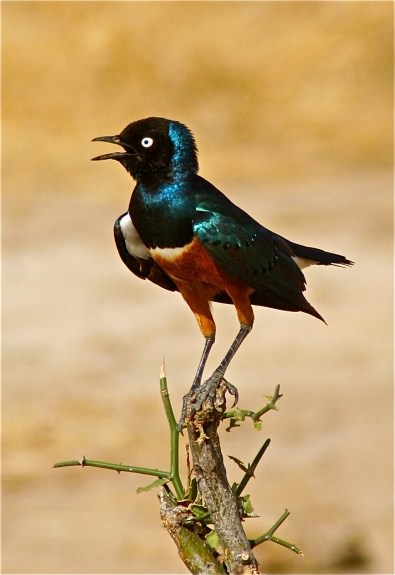
Lamprotornis superbus / Superb Starling. Ruaha National Park. It looks like it’s singing, but what it is actually doing is cooling off by panting.
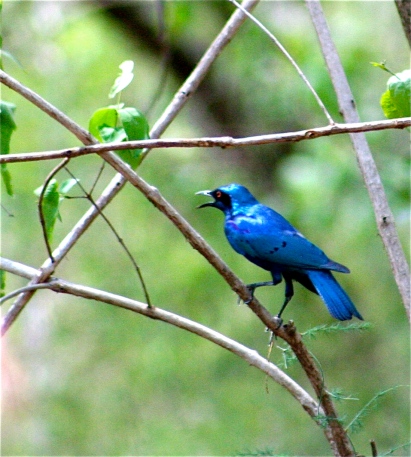
Notopholia corrusca / Black-Belly Glossy Starling. This one was in my back yard.
I’ve spent hours just sitting on the back porch shooting pictures of birds. I’ve heard more than I’ve seen, and I think I’m up to 25 different species so far. There’s a big, black hornbill that is teasing me. Either it shows up when the lighting is really poor, or it hides in the branches and I can’t get the shot. Oh…but I will.
Took me a while, but I finally got this next one. When it flies, all you see is this brilliant, breathtaking flash of magenta.
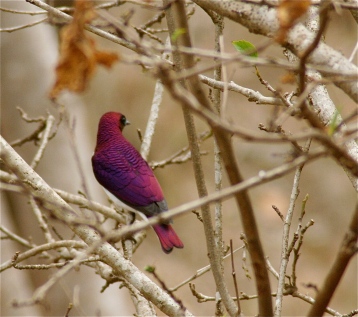
Cinnyricinclus leucogaster / Violet-backed Starling. Sometimes this bird is hard to see. The sun has to hit it at just the right angle. Also taken in my backyard.
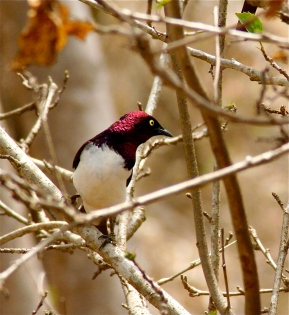
Cinnyricinclus leucogaster / Violet-backed Starling. Front view with that yellow eye. Another backyard shot.
And last, but not least, the leopard. I’m told it’s rare to spot a leopard because they’re nocturnal. They’re not always out in the middle of the day, and if they are they’ll be camouflaged high up in a tree asleep. They don’t sleep out in the open like lions do. We were headed toward our lunch stop when I glanced out the window and saw her tail bobbing above the tall grass. Pure. Luck.
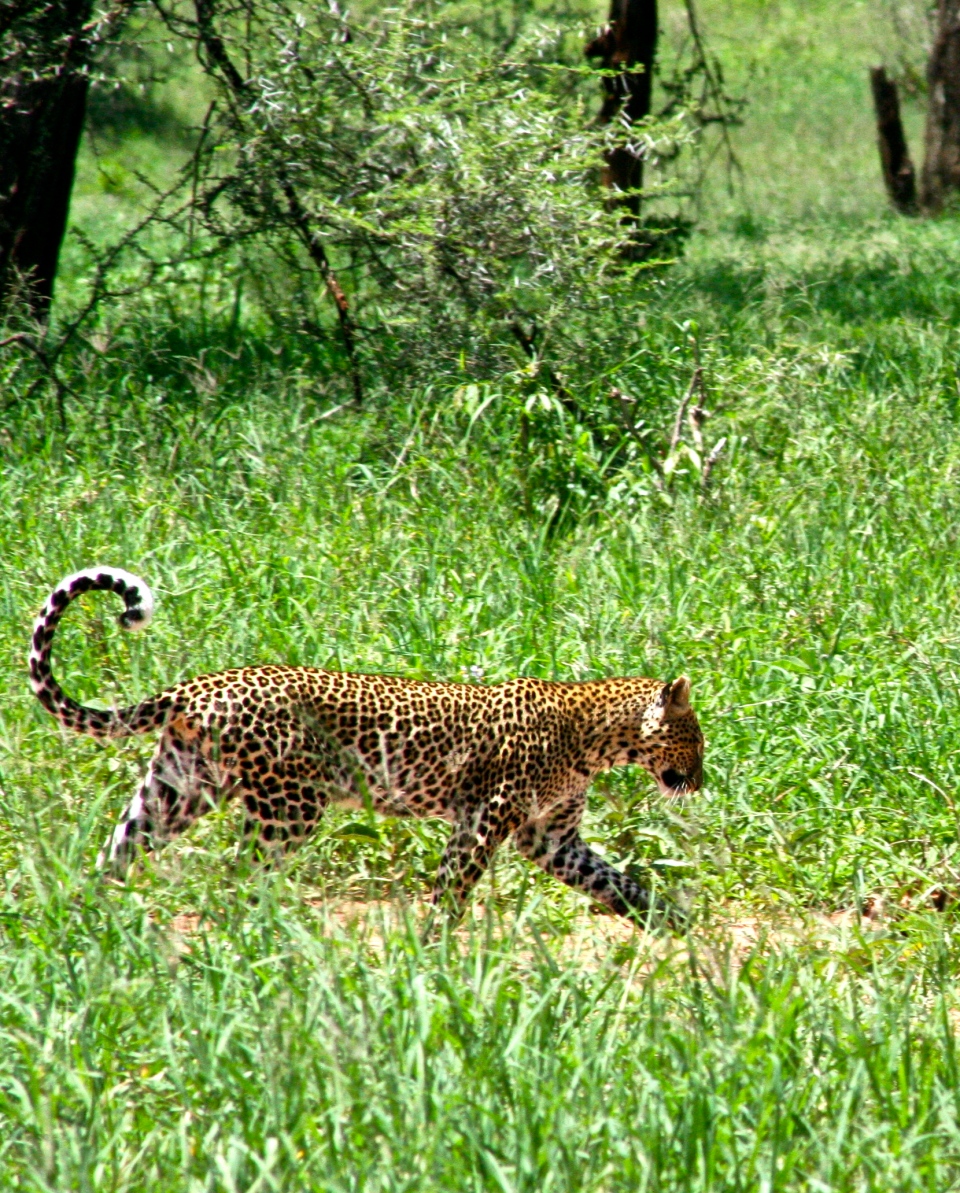
Panthera pardus / leopard. Tarangire National Park. She had just emerged from the tall grass and was loping toward her next tree at a leisurely rate. That tail has a life of its own. The fluidity of motion this animal possesses is absolutely entrancing.
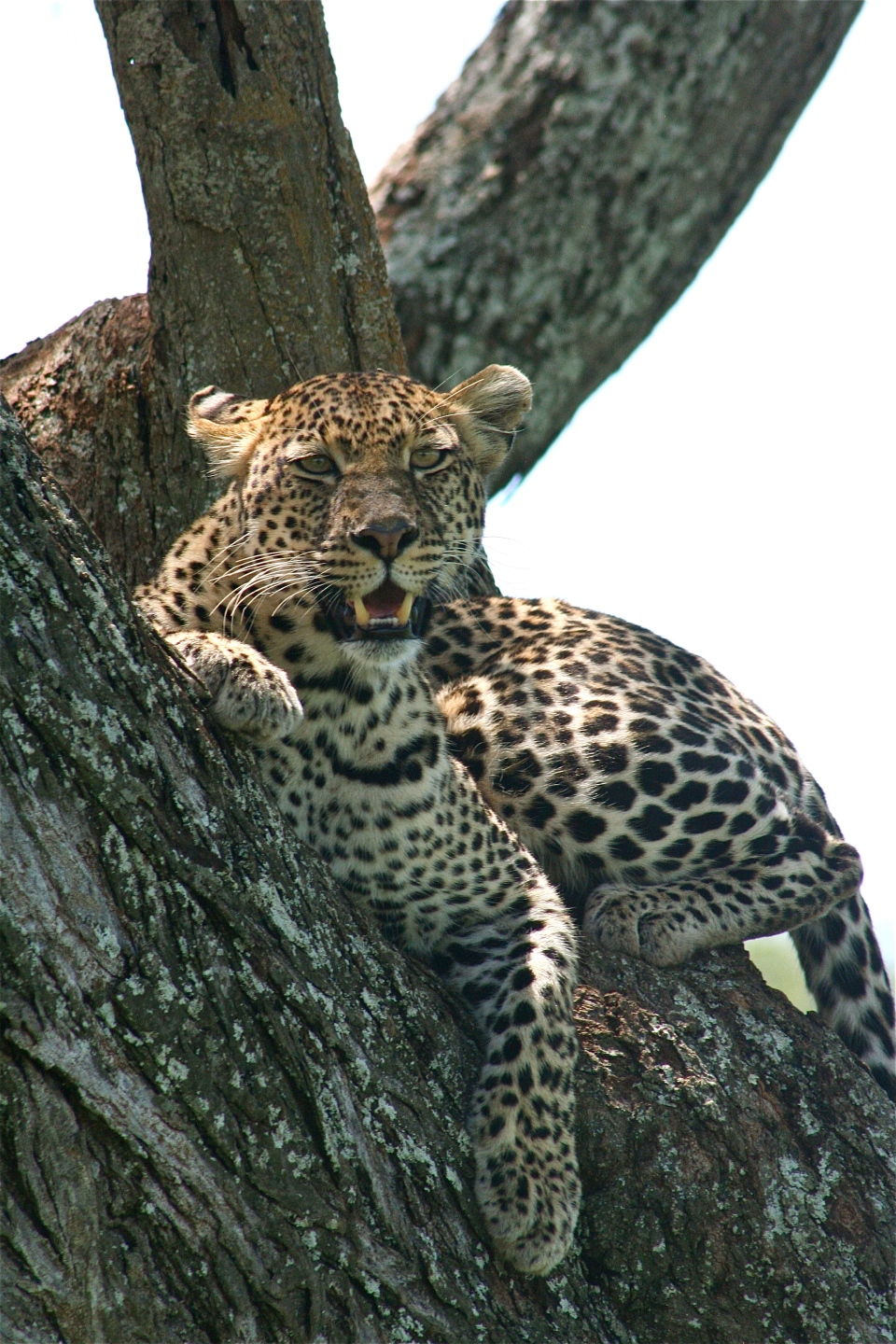
Panthera pardus / leopard. Tarangire National Park. We followed her to the tree and drove right up under it. Didn’t phase her one bit.
Alright – there’s your animal pics. I’m hoping to head toward The Serengeti and Ngorongoro this summer, then Ruaha again, Mikumi and a couple of other parks. Going back to Zanzibar is also on that list.
Oh, sorry if the formatting is messed up. A post looks one way in the “edit” window and another in the “preview” window. I don’t have the patience to sort that out.
Holy cow you got some AMAZING shots…that one of the lioness and vulture could be in National Geo! Do you have (at home in the US perhaps) Adobe Photoshop? That one of the hippo that is a tad blown out, you might be able to recover some value/contrast in it, and make the ones of the dust clouds on the feet of the lioness even more amazing. And I envy you the birds…I first started “birding” from my living room in Gabon. We had at least four or five nectarinidae (the African equivalent to hummingbirds) that came to the garden, another four or five kinds of weavers including the Whydah / widow bird (all black, ridiculously long tail). Lately I’ve felt like most of my travel is behind me, not so interested in hot places and third world places, but I may have to get back to Africa after this post! Just WOW! Thanks for sharing.
LikeLike